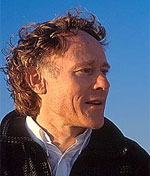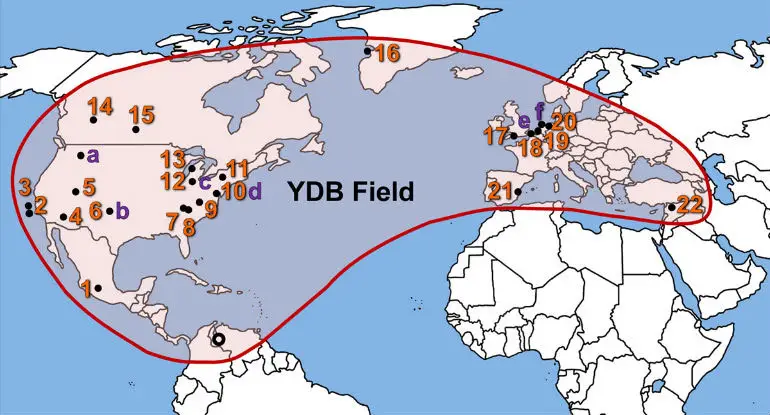30th January 2015
Guest Writer for Wake Up World
The graphic shows the vast swathe of our planet that geologists call the Younger Dryas Boundary Field. The tell-tale traces of multiple impacts by the fragments of a giant comet have been found across this huge “fingerprint”, spanning North America, Central America, parts of South America, most of Europe and parts of the Middle East as well. Some of these comet fragments were two kilometres or more in diameter.
They are estimated to have hit the Earth like a blast from a cosmic scatter-gun around 12,800 years ago. This was near the end of the last Ice Age, from which our world had been emerging into a pleasant warming phase, but these impacts set in train a kind of “nuclear winter” and plunged the planet back into a period of deep cold and darkness that lasted until around 11,500 years ago. It is this period of extreme cold that is referred to as the Younger Dryas (after a characteristic Alpine tundra wildflower, Dryas octopetala) but it is only now, with conclusive evidence of the comet impact, that we can be sure what caused it.
For the past seven years academics have been involved in such an intense dispute about whether or not a comet impact actually occurred 12,800 years ago that the implications of what it might have meant for the story of civilisation have not yet been considered. But every attempt to refute the impact evidence has in turn been refuted, and the case for the Younger Dryas comet is now so compelling that it is time to widen the debate.
Fingerprint Of A Global Cataclysm
It is clear now that some of the largest fragments of the comet hit the North American ice cap, which was still a mile deep 12,800 years ago, and caused cataclysmic flooding (I had the opportunity to explore some of the extraordinary effects of this on the ground in September 2014 when I drove from Portland, Oregon, to Minneapolis, Minnesota, with catastrophist researcher Randall Carlson).
Simultaneously other large fragments hit the northern European ice cap with the same cataclysmic effects. The result was a global disaster that lasted for 1,300 years. It is, I believe, the “smoking gun” that made us a species with amnesia and wiped out almost all traces of a former high civilisation of prehistoric antiquity. But there were survivors, who preserved at least some of the knowledge of the civilisation that had been destroyed with the intention of transmitting it to future generations, so it is not an accident that the first traces of the re-emergence of civilisation, in the form of the earliest known megalithic architecture and the re-promulgation of agricultural skills, occur at Gobekli Tepe in Turkey 11,500 years ago — a date that coincides exactly with the end of the Younger Dryas and the return to a more congenial global environment.
Everything we have been taught about the origins of civilisation occurs after 11,500 years ago — in other words, after the radical punctuation mark of the Younger Dryas. It is what happened before that we desperately need to recover. These are amongst the mysteries that I am exploring in Magicians of the Gods, the book that I have been researching for the past three years and am now in the midst of writing.
Image: Graphic from Kinzie, Firestone, Kennett et al. “Nanodiamond-Rich Layer across Three Continents Consistent with Major Cosmic Impact at 12,800 Cal BP”, The Journal of Geology, 2014, volume 122, p. 475–506.
Previous articles by Graham Hancock:
- The Consciousness Revolution
- New Archaeological Discoveries Uncover the Mysteries of a Lost Civilisation
- The War On Consciousness
- Giving up the Green: Reflections on Cannabis, Ayahuasca and the Mystery of Plant Teachers
About the author:
 Graham Hancock is the author of the major international bestsellers The Sign and The Seal, Fingerprints of the Gods, Heaven’s Mirror and Keeper Of Genesis. His books have sold more than five million copies worldwide and have been translated into 27 languages. His public lectures, radio and TV appearances, including two major TV series for Channel 4 in the UK (Quest For The Lost Civilisation) and The Learning Channel in the US (Flooded Kingdoms of the Ice Age) have put his ideas before audiences of tens of millions. He has become recognised as an unconventional thinker who raises controversial questions about humanity’s past.
Graham Hancock is the author of the major international bestsellers The Sign and The Seal, Fingerprints of the Gods, Heaven’s Mirror and Keeper Of Genesis. His books have sold more than five million copies worldwide and have been translated into 27 languages. His public lectures, radio and TV appearances, including two major TV series for Channel 4 in the UK (Quest For The Lost Civilisation) and The Learning Channel in the US (Flooded Kingdoms of the Ice Age) have put his ideas before audiences of tens of millions. He has become recognised as an unconventional thinker who raises controversial questions about humanity’s past.
In 2002 Hancock published Underworld: Flooded Kingdoms of the Ice Age to great critical acclaim, and hosted the accompanying major TV series. This was the culmination of years of research and on-hand dives at ancient underwater ruins. Arguing that many of the clues to the origin of civilization lay underwater, flooded at the end of the last Ice age, Underworld offered tangible archaeological evidence that myths and legends of ancient floods were not to be dismissed.
Hancock’s most recent ventures include Talisman: Sacred Cities, Secret Faith which explores evidence of the continuation into modern times of a secret astronomical cult, Supernatural: Meetings with The Ancient Teachers of Mankind, an investigation of shamanism and the origins of religion, and his latest book Entangled, a work inspired by his experience of the visionary brew Ayahuasca.
To learn more, visit grahamhancock.com or follow Graham on Facebook. You can read his full bio here.

If you've ever found value in our articles, we'd greatly appreciate your support by purchasing Mindful Meditation Techniques for Kids - A Practical Guide for Adults to Empower Kids with the Gift of Inner Peace and Resilience for Life.
In the spirit of mindfulness, we encourage you to choose the paperback version. Delve into its pages away from screen glare and notifications, allowing yourself to fully immerse in the transformative practices within. The physical book enriches the learning process and serves as a tangible commitment to mindfulness, easily shared among family and friends.
Over the past few years, Wake Up World has faced significant online censorship, impacting our financial ability to stay online. Instead of soliciting donations, we're exploring win-win solutions with our readers to remain financially viable. Moving into book publishing, we hope to secure ongoing funds to continue our mission. With over 8,500 articles published in the past 13 years, we are committed to keeping our content free and accessible to everyone, without resorting to a paywall.







